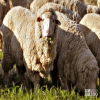Ovis aeries
A sheep's body is covered with wool and needs cut at least once a year. Females have no horns, are called "ewes" and weigh from 100 to 120 pounds. One sheep produces from 14-18 pounds of fleece per season. Males have spiral horns, are called "rams" and weigh from 160 to 180 pounds. The young are called "lambs" and on average weigh about 5 to 8 pounds. Their faces and legs wool are white. Merino sheep see in color, have a "270 degree field of vision" and do not have to turn their head to see behind them. They have excellent hearing and a highly developed sense of smell. There are no teeth in the upper front jaw, but rather lower front teeth that press against an upper palette. The upper lip is split which allows them to select their favorite leaves from a plant. They have hooved feet. Sheep are ruminants with four stomach chambers. Merino sheep were bred mainly for the wool they produce and are still regarded as having some of the finest and softest wool of any sheep. The Merino breed originated in Southwestern Iberia (Spain), but the modern Merino sheep was domesticated in New Zealand and Australia.

